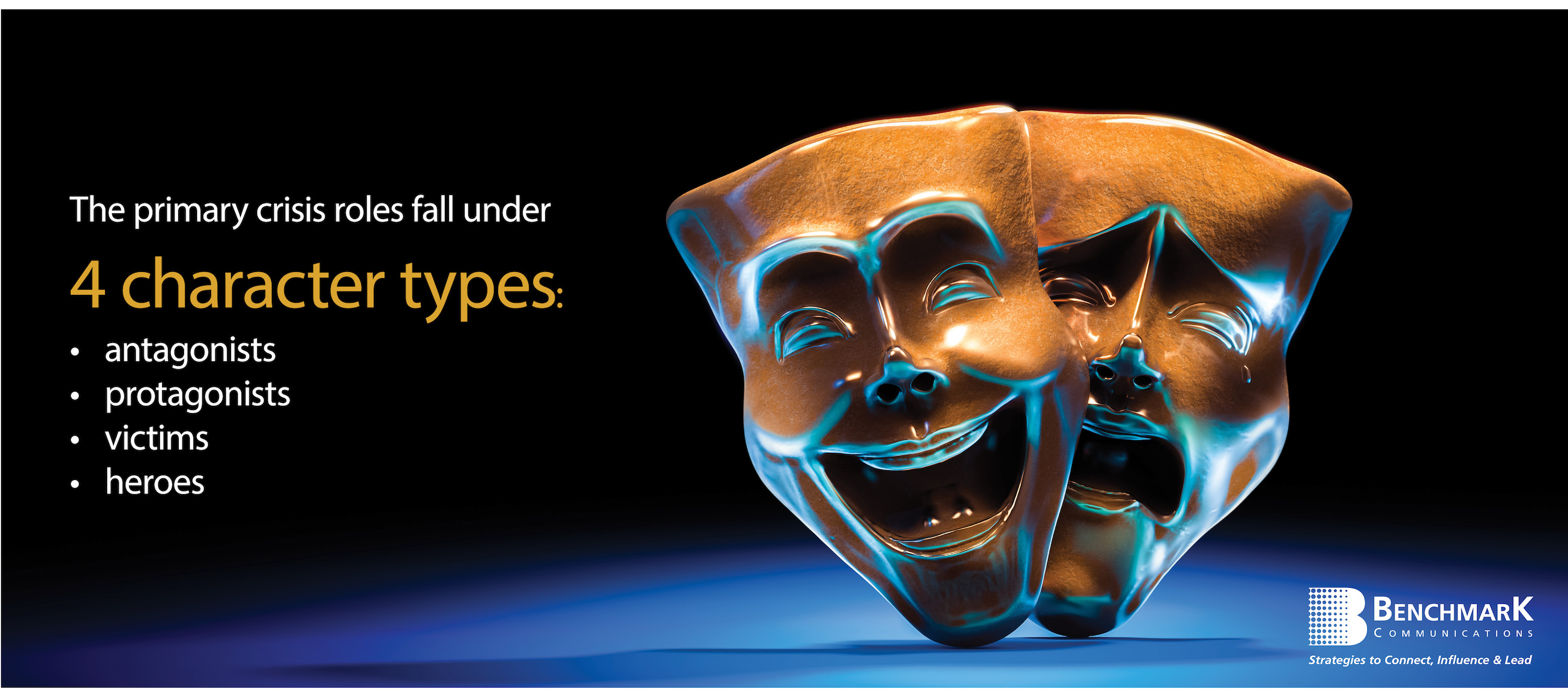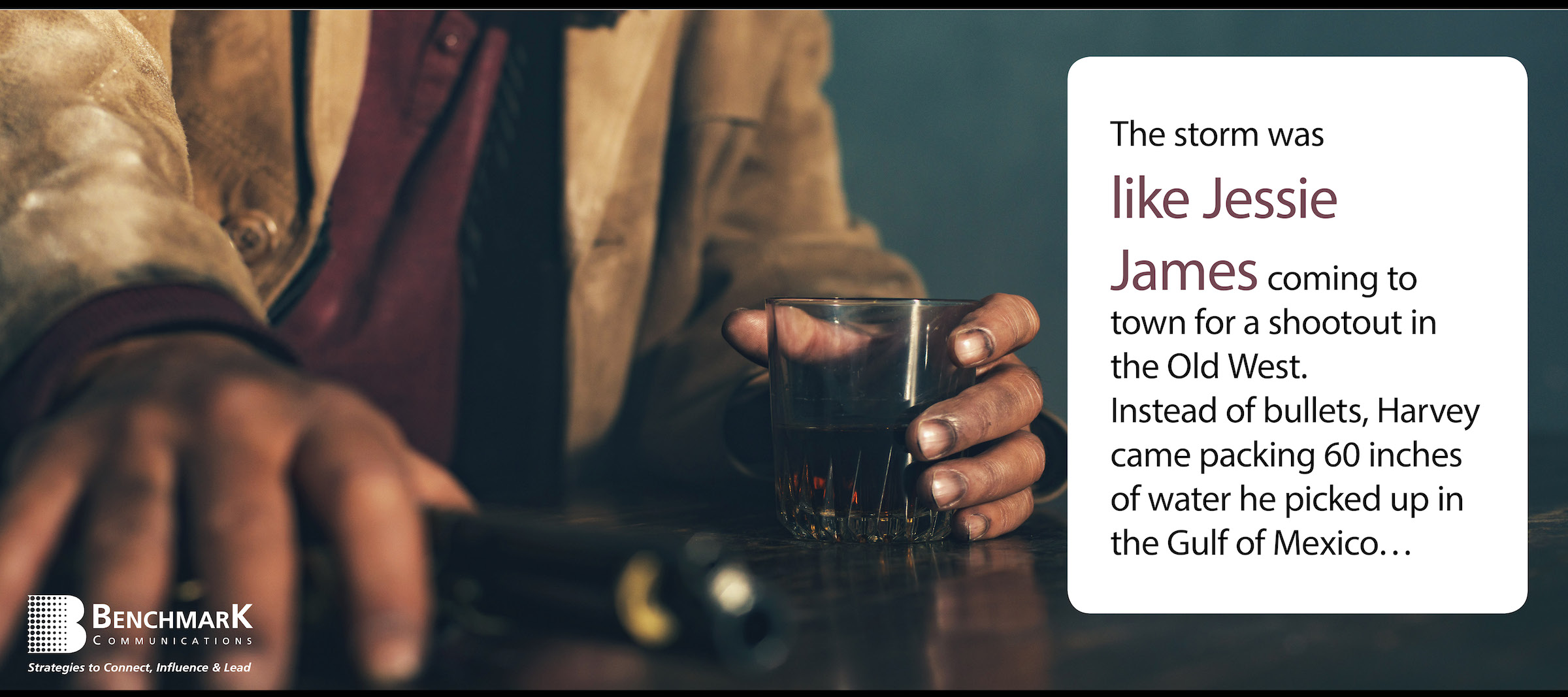Hurricane Harvey Crisis Management Lessons
One year ago this week, Hurricane Harvey brought deadly drama to 54 counties across Southeast Texas. For four long days, this Moby Dick-sized storm pounded millions with winds, tornadoes and 60 inches of rain. Those of us who lived through Harvey will never forget this Noah-type experience. We reflect back on the crisis lessons and the four character roles played out during this devastating crisis drama.
Crisis Management – Storylines & Characters
Effective crisis management and crisis communications response requires an understanding of emotions, characters and storylines. Emotions drive public perceptions, and storylines are played out as information becomes available and organizations roll out their response. Characters emerge from the crisis storylines, much like you experience in a play or novel. These character roles and how they are played greatly influence how a crisis is remembered, who overcomes and who succumbs to the crisis drama. The primary crisis roles fall under four character types: antagonists, protagonists, victims and heroes. The story of Hurricane Harvey belongs to the heroes, and there are some worthwhile crisis management lessons from all four primary character roles played in this disaster. Our team of reputation management consultants use this type of knowledge to help our clients improve their crisis planning and crisis response.
Crisis Management – The Antagonist
In most crises, the role of the antagonist typically falls to the individual or organization responsible for delivering the tension birthed out of a negative issue or event. It is important to understand that delivering a crisis is not necessarily the equivalent of causing a crisis. To survive a crisis, the antagonist must respond quickly, be transparent, show remorse and present a strong plan of action to convince others they are worthy of recovery and forgiveness. Think about Uber’s crisis. Uber is attempting to show a plan of action to overcome its antagonist role. Uber is taking steps to earn forgiveness for a culture that was revealed as sexist and corrupt. They fired their CEO, brought in new characters with a promise to clean things up and rebuild trust with customers. These new characters are attempting to redeem the organization’s reputation, and only time will tell the outcome of the Uber story. Chipotle Mexican Grill is another organization still struggling with its crisis response to prove that customers can trust the safety of their food.
In the case of Hurricane Harvey, the storm itself was the crisis antagonist – a powerful, relentless, unforgiving, destructive and deadly force. The storm was the equivalent of Jessie James coming to town for a shootout in the Old West. Instead of bullets, Harvey came packing 60 inches of water he picked up in the Gulf of Mexico, tornadoes and 130 mile per hour winds. As people realized Hurricane Harvey was headed toward their towns, some scattered and most hid out in their homes. But, Harvey came to make a name for himself and he did – the storm is expected to rank among the costliest US natural disasters.
Crisis Management – The Protagonist
During a crisis the protagonist is the character responsible for addressing the main problem. In the Hurricane Harvey crisis, hundreds of local leaders across 54 drenched Texas counties served in the protagonist role. These leaders ran the “mission control” of the crisis response and crisis communications: mayors, county judges, city managers, heads of law enforcement, water management officials, transportation officials, and others coordinated the response and kept the public updated on their progress and issues. Considering the magnitude of the crisis, these leaders appeared to work seamlessly and in great harmony – a sign of effective crisis planning and crisis leadership.
During a crisis, the protagonist role can fall to a range of players, and it can even be the collective voice of society through social media; this happened earlier this year when a video went viral of a bloodied United Airlines passenger being extracted from a plane. The public outcry on social media forced United to immediately change its crisis response, crisis communications approach and policies to solve the problem.
It is important to understand that the protagonist role can also be earned by the leader of the organization that delivers the crisis. The antagonist leader can be transformed into the role of the protagonist! This was the case when Canada’s Maple Leaf Foods delivered contaminated meat that killed 20 people. But, because of the thorough, sincere and empathetic crisis response, of their CEO, Michael McCain, the Canadian Press honored him as “Business Newsmaker of the Year”. Consumer trust in the company also increased in the wake of that tragedy.
Crisis Management – The Victims
The crisis victims are the ones most impacted and suffer at the hands of the crisis antagonist. People from across the world have expressed amazement at the suffering of Harvey’s victims. Overall, the hurricane claimed at least 130 lives, devastated many businesses and left more than 185,000 residents homeless. Approximately 560,000 people have registered for FEMA assistance and more than 53,000 are still in hotels. Harvey destroyed infrastructure and also took a toll on livestock and wildlife; even deer and armadillos were rescued from the floodwaters.
Crisis Management – The Heroes
The heroes are those who take action to help the victims or stop a crisis from becoming worse. The hero role can fall to a range of people or groups – first responders, community leaders, politicians, spokespersons for a responding organization, incident commanders, employees, a whistleblower or others. In the case of Hurricane Harvey, there were thousands of heroes, but the ones with the most press coverage might be remembered more than others. Local and national news outlets featured heroes like Mattress Mac, (Jim McIngval) the owner of a Houston furniture store dynasty. McIngval became an instant hero when he turned his stores into shelters for flood victims and emergency responders. The media also focused on popular Houston Texan football player, JJ Watt. Watt earned hero status for raising more than $37 million for Hurricane Harvey victims. The media then contrasted Watt and McIngval to celebrity minister, Joel Osteen, who earned villain status for NOT opening his church doors to flooded victims. It is important to note that the Osteen storyline originated on social media as people started questioning his lack of action to help people. Then, the traditional media picked up the story and put a national spotlight on Osteen and his multi-million dollar church. Osteen quickly attempted to recover his reputation with media interviews.
Hurricane Heroes and Social Media Power
There are so many deserving heroes in the story of Harvey, and at the top of that list are the thousands of citizen responders that raced to the flooded areas with boats, trucks and trailers to save the flood victims. On social media you saw people from small and big towns around the country loading up their U-hauls, 18-wheelers, boats and supplies and heading to Texas. During Harvey, social media became the Uber of crisis communications. It connected riders with drivers, but these riders were soaked and in harm’s way. The 911 lines were overloaded, so ordinary people relayed distress calls via social media and directed citizen responders to the flood victims.
I would not wish Hurricane Harvey on anyone, but it was amazing to witness how everyday people came together to do something extraordinary in the face of adversity and a crisis of major proportions. The citizen responders and volunteers are the true heroes of Hurricane Harvey!
Related Articles:
Reputation Management: How Crisis Leaders Are Like Movie Directors




